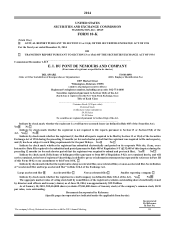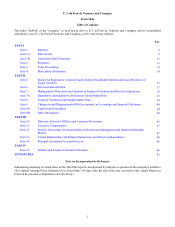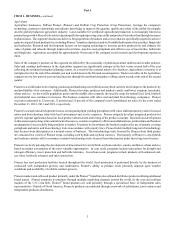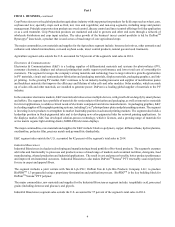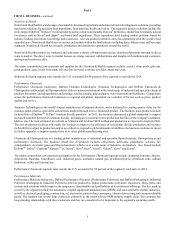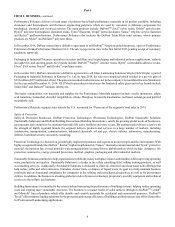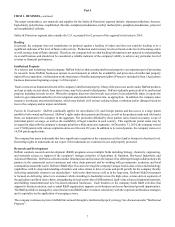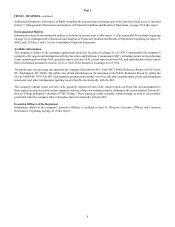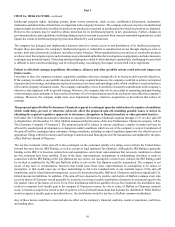DuPont 2014 Annual Report Download - page 11
Download and view the complete annual report
Please find page 11 of the 2014 DuPont annual report below. You can navigate through the pages in the report by either clicking on the pages listed below, or by using the keyword search tool below to find specific information within the annual report.Part I
ITEM 1A. RISK FACTORS, continued
10
Intellectual property rights, including patents, plant variety protection, trade secrets, confidential information, trademarks,
tradenames and other forms of trade dress, are important to the company's business. The company endeavors to protect its intellectual
property rights in jurisdictions in which its products are produced or used and in jurisdictions into which its products are imported.
However, the company may be unable to obtain protection for its intellectual property in key jurisdictions. Further, changes in
government policies and regulations, including changes made in reaction to pressure from non-governmental organizations, could
impact the extent of intellectual property protection afforded by such jurisdictions.
The company has designed and implemented internal controls to restrict access to and distribution of its intellectual property.
Despite these precautions, the company's intellectual property is vulnerable to unauthorized access through employee error or
actions, theft and cybersecurity incidents, and other security breaches. When unauthorized access and use or counterfeit products
are discovered, the company reports such situations to governmental authorities for investigation, as appropriate, and takes measures
to mitigate any potential impact. Protecting intellectual property related to biotechnology is particularly challenging because theft
is difficult to detect and biotechnology can be self-replicating. Accordingly, the impact of such theft can be significant.
Failure to effectively manage acquisitions, divestitures, alliances and other portfolio actions could adversely impact our
future results.
From time to time, the company evaluates acquisition candidates that may strategically fit its business and/or growth objectives.
If the company is unable to successfully integrate and develop acquired businesses, the company could fail to achieve anticipated
synergies and cost savings, including any expected increases in revenues and operating results, which could have a material adverse
effect on the company’s financial results. The company continually reviews its portfolio of assets for contributions to the company’s
objectives and alignment with its growth strategy. However, the company may not be successful in separating underperforming
or non-strategic assets and gains or losses on the divestiture of, or lost operating income from, such assets may affect the company’s
earnings. Moreover, the company might incur asset impairment charges related to acquisitions or divestitures that reduce its
earnings.
The proposed spin-off of the Performance Chemicals segment is contingent upon the satisfaction of a number of conditions
which could delay, prevent or otherwise adversely affect the proposed spin-off, including possible issues or delays in
obtaining the required regulatory approvals or clearances, disruptions in financial markets or other potential barriers.
In October 2013, DuPont announced its intention to separate its Performance Chemicals segment through a U.S. tax-free spin-off
to shareholders. On December 18, 2014, DuPont announced that the name of the new Performance Chemicals company will be
The Chemours Company (“Chemours”). The proposed spin-off is subject to various conditions, complex in nature and may be
affected by unanticipated developments or changes in market conditions which are out of the company’s control. Completion of
the spin-off will be contingent upon customary closing conditions, including receipt of regulatory approvals, the effectiveness of
appropriate filings with the Securities and Exchange Commission and final approval of the transactions contemplated by the spin-
off by DuPont’s Board of Directors.
The tax-free treatment of the spin-off is also contingent on the continued validity of a ruling received from the United States
Internal Revenue Service (IRS Ruling), as well as receipt of legal opinions (Tax Opinion). Although the IRS Ruling is generally
binding on the IRS, it is based on certain facts and assumptions, and certain representations that necessary conditions to obtain
tax-free treatment have been satisfied. If any of the facts, representations, assumptions or undertakings described or made in
connection with the IRS Ruling or the Tax Opinion are not correct, are incomplete, or have been violated, the IRS Ruling could
be revoked or modified by the IRS and DuPont's ability to rely on the Tax Opinion could be jeopardized. The company is not
aware of any facts or circumstances, however, that would cause these facts, representations or assumptions to be untrue or
incomplete, or that would cause any of these undertakings to fail to be complied with, in any material respect. If the spin-off
distribution, and/or related internal transactions, were to be determined taxable, DuPont or Chemours could incur significant U.S.
federal income tax liabilities. In addition, if the spin-off were deemed to be taxable, each holder of DuPont common stock who
received shares of Chemours would generally be treated as receiving a taxable distribution of property in an amount equal to the
fair market value of the shares received. Even if the distribution otherwise qualifies for tax-free treatment, the distribution may
result in a corporate level taxable gain to the company if 50 percent or more, by vote or value, of DuPont or Chemours common
stock, is treated as acquired or issued as part of a plan or series of related transactions that includes the distribution. While DuPont
would recognize a taxable gain as described above, the distribution would be tax-free to DuPont common stockholders.
Any of these factors could have a material adverse effect on the company’s financial condition, results of operations, cash flows
and trading price.

